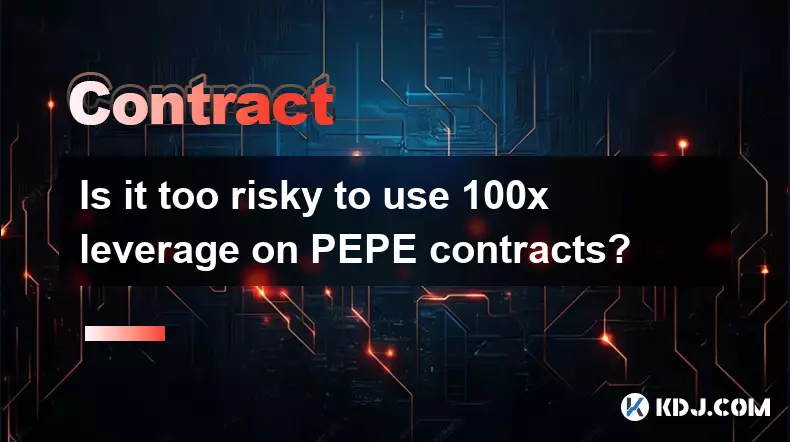-
 bitcoin
bitcoin $122659.385674 USD
0.52% -
 ethereum
ethereum $4484.113342 USD
-0.09% -
 bnb
bnb $1304.229256 USD
-0.85% -
 tether
tether $1.000204 USD
-0.03% -
 xrp
xrp $2.860636 USD
-0.51% -
 solana
solana $227.288799 USD
2.36% -
 usd-coin
usd-coin $0.999805 USD
0.01% -
 dogecoin
dogecoin $0.252837 USD
1.18% -
 tron
tron $0.341149 USD
1.12% -
 cardano
cardano $0.830507 USD
0.33% -
 hyperliquid
hyperliquid $45.792319 USD
0.04% -
 chainlink
chainlink $22.422164 USD
1.55% -
 ethena-usde
ethena-usde $1.000283 USD
0.01% -
 sui
sui $3.511389 USD
0.83% -
 stellar
stellar $0.385276 USD
-0.44%
Is it too risky to use 100x leverage on PEPE contracts?
Trading PEPE with 100x leverage amplifies gains and losses, making even minor price swings a threat to total account loss due to narrow liquidation buffers.
Oct 09, 2025 at 04:18 pm

Understanding 100x Leverage in PEPE Contracts
1. Trading PEPE contracts with 100x leverage allows traders to control a much larger position using a small amount of capital. For example, with just $100, a trader can open a $10,000 position. This level of exposure dramatically amplifies both potential gains and losses.
2. The high volatility of meme coins like PEPE makes them particularly sensitive to price swings. Even minor market movements can trigger liquidations when such extreme leverage is applied. A price shift of less than 1% against the position could result in total loss of margin.
3. Liquidation mechanisms on most derivatives exchanges automatically close positions once the margin threshold is breached. With 100x leverage, the buffer before liquidation is extremely narrow, leaving little room for market recovery or strategy adjustment.
4. Funding rates on perpetual PEPE contracts can be highly unpredictable due to speculative interest. Holding leveraged positions over time may incur significant costs, especially during periods of one-sided market sentiment.
Extreme leverage magnifies risk exponentially, turning even routine market noise into a threat of complete account wipeout.Market Dynamics Impacting PEPE Volatility
1. PEPE’s price action is largely driven by social sentiment, influencer mentions, and trending narratives rather than fundamental metrics. This behavioral dependency leads to erratic price jumps and sharp corrections that are difficult to anticipate.
2. Low circulating supply concentration means large holders, often referred to as 'whales,' can manipulate short-term price direction. Sudden sell-offs or coordinated buying can destabilize leveraged positions within seconds.
3. Trading volume on PEPE futures varies significantly across platforms. On smaller exchanges, slippage during fast-moving markets can distort entry and exit prices, further endangering high-leverage trades.
4. News cycles related to broader crypto regulation or macroeconomic data can trigger cascading liquidations in highly leveraged environments. PEPE, being a speculative asset, tends to react more violently than established cryptocurrencies under such conditions.
The absence of intrinsic value and reliance on viral momentum make PEPE exceptionally dangerous under maximum leverage scenarios.Risk Management Challenges with High Leverage
1. Most retail traders lack the tools or experience to monitor 100x leveraged positions effectively. Without real-time alerts and tight stop-loss mechanisms, positions can liquidate before intervention is possible.
2. Emotional decision-making increases under high-pressure trading conditions. Traders using full leverage often fall into the trap of doubling down on losing positions, accelerating capital depletion.
3. Exchange infrastructure limitations, including delayed order execution or API downtime during peak volatility, can prevent timely exits. These technical risks compound the dangers of operating at maximum leverage.
4. Margin requirements fluctuate based on market conditions. Some platforms increase maintenance margins during high volatility, reducing the effective leverage tolerance without prior notice.
Proper risk controls are nearly impossible to maintain when trading PEPE with 100x leverage due to the speed and unpredictability of price action.Frequently Asked Questions
What happens when a 100x leveraged PEPE position gets liquidated?When the loss on a leveraged position reaches the deposited margin, the exchange automatically closes the trade. In the case of 100x leverage, this can occur from a price movement as small as 1%. The trader loses the entire initial margin, and in some cases, may owe additional fees depending on the platform's clawback policies.
Can I reduce my effective leverage while keeping the same position size?Yes. By adding more margin to the position, the leverage ratio decreases. For instance, increasing the collateral on a $10,000 position from $100 to $500 reduces leverage from 100x to 20x. This improves the liquidation price buffer and enhances survival during volatility.
Are there alternatives to using 100x leverage on PEPE?Traders can gain exposure to PEPE price movements with lower leverage or through spot purchases. Derivatives platforms also offer options contracts, which cap downside risk to the premium paid. These methods provide participation in price swings without the constant threat of liquidation.
Disclaimer:info@kdj.com
The information provided is not trading advice. kdj.com does not assume any responsibility for any investments made based on the information provided in this article. Cryptocurrencies are highly volatile and it is highly recommended that you invest with caution after thorough research!
If you believe that the content used on this website infringes your copyright, please contact us immediately (info@kdj.com) and we will delete it promptly.
- Shiba Inu Price Crash? Layer Brett Captures Meme Coin Spotlight
- 2025-10-09 19:05:14
- XRP Tokens: Can Owning Them Actually Make You Rich, Ya Know?
- 2025-10-09 18:45:15
- ADA Whales: Riding the Support Wave to Potential Gains?
- 2025-10-09 18:25:16
- Millionaire Trader's XRP Chart: Investor Challenge or Golden Ticket?
- 2025-10-09 19:25:12
- H Mining: Navigating Crypto Investing with Risk Mitigation
- 2025-10-09 18:45:15
- Riding the Crypto Rollercoaster: IPO Genie, Crypto Presales, and Liquidation Lessons
- 2025-10-09 18:25:16
Related knowledge

How to calculate the ROI for Ethereum contracts?
Oct 09,2025 at 04:36pm
Understanding Ethereum Contract ROI Basics1. Return on Investment (ROI) for Ethereum contracts begins with tracking the initial capital deployed into ...

What are the settlement procedures for XRP contracts?
Oct 09,2025 at 04:01pm
Understanding XRP Futures and Derivative Contracts1. XRP derivative contracts are typically offered by cryptocurrency exchanges that support margin tr...

How to reduce trading fees for Bitcoin contracts?
Oct 09,2025 at 02:37pm
Understanding Bitcoin Contract Trading Fees1. Trading fees on Bitcoin contracts are typically charged by exchanges for executing buy and sell orders. ...

Is it too risky to use 100x leverage on PEPE contracts?
Oct 09,2025 at 04:18pm
Understanding 100x Leverage in PEPE Contracts1. Trading PEPE contracts with 100x leverage allows traders to control a much larger position using a sma...

Is it possible to lose more than my initial investment with Dogecoin contracts?
Oct 09,2025 at 02:00pm
Understanding the Risks of Dogecoin Futures Trading1. Trading Dogecoin futures contracts introduces financial exposure that extends beyond the origina...

What is the difference between futures and perpetual contracts for Bitcoin?
Oct 02,2025 at 11:54pm
Understanding Bitcoin Futures Contracts1. Bitcoin futures are derivative instruments that allow traders to speculate on the future price of Bitcoin at...

How to calculate the ROI for Ethereum contracts?
Oct 09,2025 at 04:36pm
Understanding Ethereum Contract ROI Basics1. Return on Investment (ROI) for Ethereum contracts begins with tracking the initial capital deployed into ...

What are the settlement procedures for XRP contracts?
Oct 09,2025 at 04:01pm
Understanding XRP Futures and Derivative Contracts1. XRP derivative contracts are typically offered by cryptocurrency exchanges that support margin tr...

How to reduce trading fees for Bitcoin contracts?
Oct 09,2025 at 02:37pm
Understanding Bitcoin Contract Trading Fees1. Trading fees on Bitcoin contracts are typically charged by exchanges for executing buy and sell orders. ...

Is it too risky to use 100x leverage on PEPE contracts?
Oct 09,2025 at 04:18pm
Understanding 100x Leverage in PEPE Contracts1. Trading PEPE contracts with 100x leverage allows traders to control a much larger position using a sma...

Is it possible to lose more than my initial investment with Dogecoin contracts?
Oct 09,2025 at 02:00pm
Understanding the Risks of Dogecoin Futures Trading1. Trading Dogecoin futures contracts introduces financial exposure that extends beyond the origina...

What is the difference between futures and perpetual contracts for Bitcoin?
Oct 02,2025 at 11:54pm
Understanding Bitcoin Futures Contracts1. Bitcoin futures are derivative instruments that allow traders to speculate on the future price of Bitcoin at...
See all articles










































































